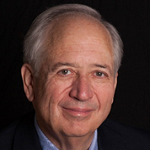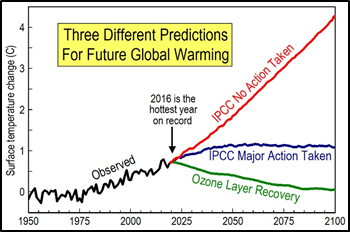Below is our recent interview with Peter L. Ward:

Q: Dr. Ward, let’s start with your background. How did you get to where you are today?
A: From an early age, I have had an insatiable curiosity, wondering how things work. Plus, I have always felt driven to take action—if something is important to me and needs to be done, I just roll up my sleeves, work twice as hard, and make it happen.
I climbed my first erupting volcano at age 19, earned a BA in geology and physics from Dartmouth College, and earned a PhD in geophysics from Columbia University. I worked 27 years with the United States Geological Survey in Menlo Park, California, where, at age 31, I began leading a research group of 40 PhDs and 100 support staff, playing a lead role in creating and initially managing a major national research program.
I have testified twice before Congress, chaired a committee at the White House, worked on a committee for Vice President Gore and been featured on Good Morning America. I earned two national awards for educating the public about natural hazards. Plus, I am a well-published research scientist specializing in volcanoes, earthquakes, plate tectonics, geologic history, and climate. I have learned over many decades of very hard work what good objective science is— how to manage it and especially how to do it.
In 2006, while retired, I came across excellent data from ice cores in Greenland showing that the greatest volcanism recorded in Greenland ice was contemporaneous with the period of greatest warming at the end of the last ice age. This implied that volcanoes might have caused the warming. But that did not make sense because all volcanologists know that major, explosive volcanic eruptions cause global cooling of nearly one-degree Fahrenheit for 2 to 4 years. How could volcanoes cause both global cooling and global warming?
The more I looked at the detailed data, the more I began to realize that figuring this enigma out could be very important. I decided to put aside everything else in my life so that I could focus full time on this issue. Being retired, I have had the privilege to work 14 years, with minimal distraction, at my own expense. Simply trying to satisfy my own curiosity. Simply trying to understand the physics of climate change. What physically causes warming and cooling? My only obligation has been to myself, to do the very best science I could. I have been through more than 10,000 scientific papers, shelves of books, hundreds of websites. I have been to dozens of scientific meetings and have interacted with thousands of scientists. I have always enjoyed being totally immersed in a problem that I am convinced is fundamentally important. This work has been grueling, but very rewarding because it has turned out to be far more important than I had ever imagined.
Q: So how do volcanoes cause cooling and warming?
A: It turns out that there are two fundamentally different types of volcanism typical of two very different geologic environments. The first type are big explosive eruptions that eject megatons of gases and debris into the lower stratosphere where they form an aerosol or mist that reflects and scatters sunlight for a few years. Several large explosive eruptions each century, continuing for millennia, are observed to cool oceans slowly, incrementally, down into ice-age conditions.
The second type is effusive volcanoes that extrude black, basaltic lava over tens to millions of square miles of land, convecting large amounts of chlorine and bromine into the lower stratosphere, causing depletion of the ozone layer and rapid global warming within years to decades. Throughout Earth history, the more extensive the basaltic lava field, the greater the contemporaneous warming and mass extinctions. There was a lava flow in Siberia 252 million years ago that covered an area almost the size of the United States. Oceans became hot-tub temperatures. More than 96% of all marine species and 70% of terrestrial vertebrate species went extinct.
Q: How does ozone depletion work?
A: This is where the science begins to get very interesting. In the 1960s, humans began manufacturing large volumes of chlorofluorocarbon gases used as spray-can propellants, refrigerants, solvents, and foam-blowing agents. It turns out that these very inert gases are broken down in the stratosphere by ultraviolet radiation, releasing atoms of chlorine. One atom of chlorine, under very cold conditions in the lower stratosphere, can destroy up to 100,000 molecules of ozone.
Ozone depletion and global temperatures began increasing around 1970 leading to the Antarctic Ozone Hole discovered in 1985. When the United Nations passed the Montreal Protocol in 1987, limiting production of chlorofluorocarbon gases, both ozone depletion and global temperatures stopped increasing by 1998. Humans had caused global warming by manufacturing large volumes of chlorofluorocarbon gases and humans took action that stopped the increase in emissions of chlorofluorocarbon gases, stopping the increase in global warming, completing the most definitive scientific experiment ever done relating changes in atmospheric temperatures to changes in concentrations of atmospheric gases.
Life as we know it on Earth is only possible because all frequencies of solar radiation greater than ultraviolet-B and most ultraviolet-B are absorbed by gases in the atmosphere above the tropopause, warming the stratosphere, which includes the ozone layer. Ultraviolet-B is the highest frequency, highest energy, hottest, solar radiation normally reaching Earth’s surface, where, with sufficient duration of exposure, it causes sunburn, skin cancer, cataracts, and mutations. If the concentration of ozone in the ozone layer is reduced—depleted—more solar ultraviolet-B radiation than usual is observed to reach Earth’s surface, cooling the ozone layer and warming Earth.
Q: But a very large consensus of scientists is convinced that global warming is caused by greenhouse gases?
A: Science is not done by consensus. As Michael Crichton said: “In science consensus is irrelevant. What is relevant is reproducible results. The greatest scientists in history are great precisely because they broke with the consensus.” There once was a very broad consensus that Earth is flat.
What is surprising is that it has never been shown by experiment, a cornerstone of the scientific method, that an increase in the concentration of greenhouse gases results in global warming. Greenhouse-warming theory is based on a number of assumptions that simply do not stand up to close scrutiny. Carbon dioxide absorbs less than 16% of radiation emitted by Earth. This energy is absorbed into the bonds holding the molecules together, which has no direct effect on gas temperature.
Temperature of a gas is well-known to be proportional to the average velocity squared that all atoms and molecules making up the gas travel through space. Furthermore, since carbon dioxide only makes up 0.04% of the gases in air, any increase in velocity of one molecule of carbon dioxide must be shared equally with 2500 other atoms and molecules. Greenhouse gases do not absorb enough thermal energy to cause the changes in temperature that we observe.
Most atmospheric scientists today assume that greenhouse gases trap heat, slowing the rate of heat lost to space, so that sun makes Earth warmer. While this assumption seems quite logical, it is based on a mistaken understanding of what heat is physically made in 1798 that still prevails today. All curves of warming or cooling of matter are asymptotic to the final temperature. The asymptotic shape shows that the rate heat flows per second is proportional to the difference in temperature between the radiating body and the absorbing body. A warmer Earth will simply radiate more heat into space. I explain the details at website Physically-Impossible.
Q: How could so many scientists be so mistaken?
A: Svante Arrhenius first quantified greenhouse warming theory in 1896. In 1900, Knut Ångström, a friend of Arrhenius and a radiation physicist, published a paper showing by two different experiments that changes in concentrations of carbon dioxide have little effect on temperature. In 1938, when Guy Callendar, a steam engineer resurrected greenhouse-warming theory from the trash heap of history, he ignored Ångström’s work. It turns out that I am the first person trained in physics since Ångström to seriously question the physics of greenhouse-gases in the literature.
What I have discovered is that our current understanding and quantification of heat is mistaken based on a mistaken assumption made in 1798 as explained in the video A Most Unexpected Revolution in the Physics of Heat. The problem is not severe for most calculations for small differences in temperature but becomes important for large differences in temperature such as between Earth at 59 degrees and Sun at nearly 10,000 degrees.
Q: How much do you expect Earth to warm in future decades?
A: The Intergovernmental Panel on Climate Change (IPCC) predicts, based on greenhouse warming theory, that global average temperatures will continue rising rapidly for the rest of this century. They claim that if we spend trillions of dollars immediately to reduce greenhouse-gas emissions, we might be able to limit the new warming. I am showing that warming since 1950 was clearly caused by depletion of the ozone layer due to humans from 1970 to 1998 and due to basaltic eruptions in 2014 and 2018. I expect global temperatures to decrease slowly as the ozone layer recovers. There should be no increase in global temperatures unless ozone is further depleted. Basaltic eruptions large enough to cause significant global warming are rare and are not highly likely to occur in our lifetimes.

Furthermore, if they do occur, recovery of the ozone layer normally occurs within a few years after the eruptions stop. All the details are readily available in my book, scientific papers, two-dozen videos, and web pages on my website WhyClimateChanges.
Q: What is your biggest challenge at this moment?
A: Greenhouse-warming theory is rapidly becoming the most expensive mistake ever made in the history of science—economically, politically, and environmentally. We are preparing to spend tens of trillions of dollars trying to reduce greenhouse-gas emissions substantially. Most of this money will be wasted. Furthermore, worldwide, political groups believing the consensus of scientists are losing elections.
I have spent most of my life near the boundary between scientific research and public policy. I believe strongly that good public policy needs to be informed by the best science available. I have been working overtime since 2015 to try to get my fellow scientists to realize there are fatal problems with greenhouse-warming theory. They need to stop and evaluate the evidence, and to then update their recommendations to society. It is not unusual during revolutions in science for scientists to be resistant to change, but in this case, time is of the essence. The costs of this mistake are skyrocketing. We need thoughtful scientific discussion now.
Activate Social Media:


